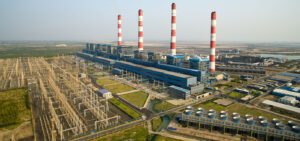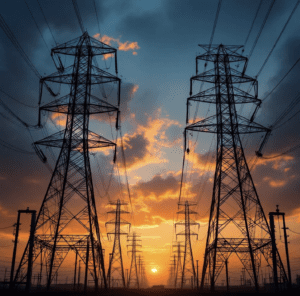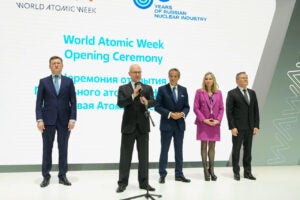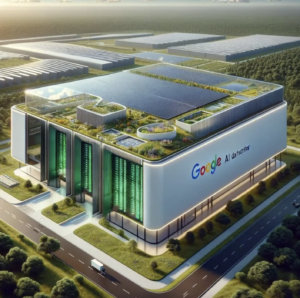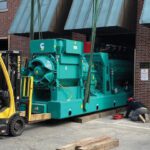The present and future of power generation is and will be driven by new technologies, those designed to increase the efficient use of electricity while limiting emissions and supporting resiliency.
It’s a challenging time for those in energy. Developing solutions to solve issues in the power sector involves navigating an uncertain and ever-changing regulatory landscape, at a time when reliable power is perhaps more important than ever. The COVID-19 pandemic also has impacted the economic viability of projects, due to construction delays and supply chain disruptions.
George Sakellaris, president and CEO of Ameresco, a renewable energy and energy efficiency company based in Framingham, Massachusetts, has a front-row seat to the evolving power marketplace. Ameresco—celebrating its 20th year in business this year—provides comprehensive services, energy efficiency, infrastructure upgrades, asset sustainability, and renewable energy solutions for businesses and organizations throughout North America and Europe.

Sakellaris took time with POWER to answer questions about himself, his company, and Ameresco’s business, as well as how his group is coping with the coronavirus pandemic.
POWER: What are the important services that companies in your space should offer when it comes to energy efficiency and renewable energy?
Sakellaris: There are a vast number of services and solutions in the energy efficiency and renewables space today—but ultimately, the ones that are most important depend on a specific organization’s needs. With efficiency, basic energy conservation measures (ECMs) such as lighting system improvements, wastewater controls and heating, ventilation and cooling (HVAC) solutions are simple and cost-effective offerings that can make a huge difference when it comes to the energy usage and cost savings of a building. Those of us that have been in the efficiency business for quite a while also know that the commercial and residential building sector is a leading source of emissions in the U.S. Especially with advances in technology and with the Internet of Things (IoT), we will see ECMs become increasingly sophisticated and interconnected, which will have a meaningful impact in how we reduce greenhouse gas emissions global and stave off the effects of climate change.
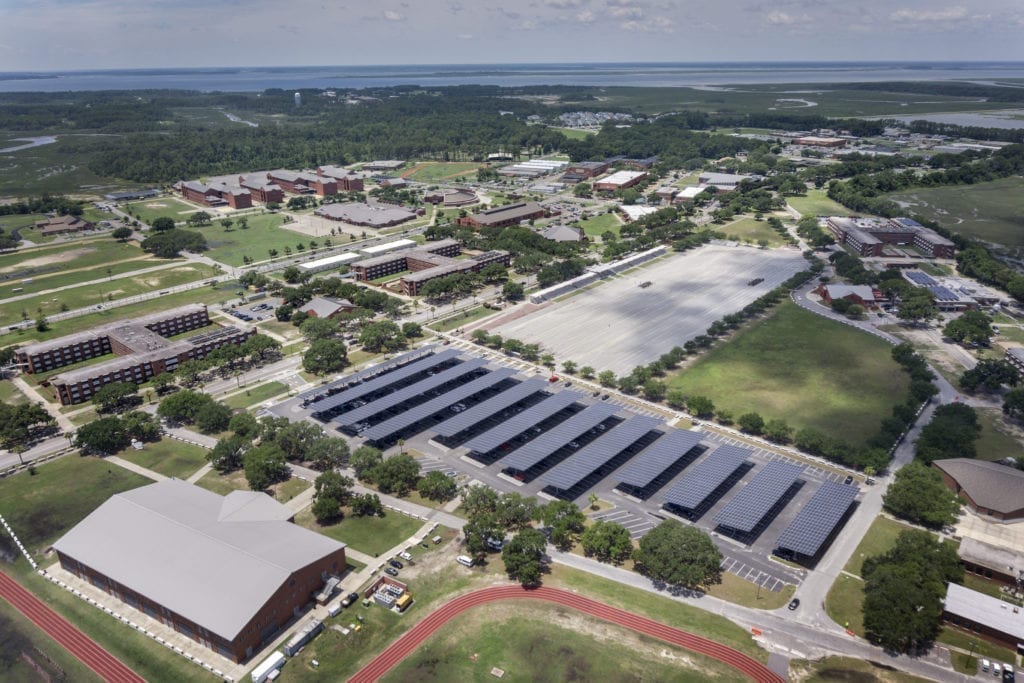
With renewable energy services, energy resilience is becoming more important as extreme weather events become more frequent, and there is increased risk of institutions losing power if their only source of energy is on the main utility grid. So, we’re seeing more companies expand their offerings of “green” power sources. Ameresco, for instance, is already very involved in solar power and renewable natural gas (RNG). Coupling these generation sources with advanced technologies like battery energy storage systems and microgrids has also become increasingly common—allowing for a level of energy reliability and resiliency that has not been seen before.
POWER: What industries does your company serve, and are there other industries that would benefit from energy efficiency?
Sakellaris: Our customers include airports, colleges and universities, healthcare facilities, K-12 schools, public housing, the federal government, and state and municipal governments. Energy efficiency and renewable energy has a place in every industry—the specific applications for each are just varied based on the individual organization’s needs.
I believe that the commercial and industrial (C&I) sector would benefit greatly from increased energy efficiency. Historically, this sector hasn’t done much with energy efficiency because landlords and property owners pass energy costs on to their tenants, so the motivation to save on those costs isn’t as strong. While owners of new buildings are more frequently prioritizing sustainability from the start, owners of older buildings must start doing the same—it is never too late for an energy efficiency retrofit. This is particularly true now, as in the past few years there have been immense technological improvements for efficiency measures, which have created more opportunities to go back and retrofit old buildings. However, there is still much that can be done to make older buildings “green,” and I hope that more and more building owners begin to see the benefits (e.g., lower energy usage and higher cost savings) and become more open-minded to investing in retrofits.
POWER: What is your background in the energy efficiency and the renewable energy sector?
Sakellaris: My time in energy efficiency started after I earned my degree from the University of Maine at Orono, as well as two master’s degrees from Northeastern University. One of my first jobs was in the early 1970s at New England Electric System, during which I created processes for encouraging businesses to practice energy conservation. Throughout my work, I helped drive massive sustainability initiatives at-scale (e.g., deep energy retrofits, solar, microgrid, battery storage, wind, geothermal, biomass, etc.). I sold my first company, NORESCO—the first energy services company in the country—to United Technologies before launching Ameresco in 2000. I was also one of the first energy solutions leaders to introduce energy savings performance contracts (ESPC), which offer businesses and municipalities the incentive of embarking on sustainability initiatives in a cost-neutral way. This financing model encourages business and municipalities to invest in sustainability before sustainability was as prominent.
POWER: What do you find is the greatest motivating factor for customers to pursue energy efficiency or renewable energy initiatives?
Sakellaris: The greatest motivating factors for customers to pursue these types of projects are cost savings and a desire to make their institutions or municipalities more sustainable to benefit both the planet and their own people. For example, many of our projects with schools provide both of these benefits; cost savings and a more comfortable working and learning environment for students, faculty, and staff as a result of the upgrades.
We just recently signed a 20-year energy savings performance contract with the State of New Hampshire. With this ESPC, we will implement energy conservation measures at more than 20 state facilities throughout the Seacoast. The state will see a significant amount of savings, and those who visit and work at those 20 facilities will experience a more comfortable environment.
POWER: How has COVID-19 impacted the energy efficiency business?
Sakellaris: COVID-19 has impacted the way we do work in order to follow all proper CDC [Centers for Disease Control] guidelines, such as social distancing. We are fortunate that at Ameresco, COVID-19 has not significantly impacted our ongoing projects. I ultimately believe that energy efficiency will be the best way to put people back to work. That is because these projects are self-funded; all that’s required is a customer’s permission to do it. As I touched on earlier, ESPCs mean that customers don’t have to worry about upfront capital, and energy efficiency projects put many, many people to work: engineers, construction teams and lots of local subcontractors. When the world opens up again, ESPCs will be an appealing way for customers to begin their sustainability projects, which will open up many jobs along the way.
POWER: What do you see in the future for clean energy?
Sakellaris: We’ll soon start to see serious advances in energy-related nanotechnologies. Microgrids will become much more economical, and battery storage will prove to be the “missing piece of the puzzle” in terms of an effective way to store electricity. Various equipment for solar, wind, biomass, and biogas-powered generation will come down more and more. We are at a pivotal moment in time as the world has seen a taste of what a cleaner planet looks like, and I hope that decision-makers do what’s right for the environment coming out of this pandemic.
POWER: What are some of your company’s most recent notable projects, and what did they accomplish?
Sakellaris: One of our recent projects that I’m very proud of is our work on behalf of the United States Marine Corps at Parris Island in South Carolina. This project involved energy efficiency measures, battery storage, combined heat and power (CHP), and other solutions to optimize resiliency. This was a challenging project in many ways, but the end results of increased energy resilience and energy efficiency have been tremendous. I am also quite proud of the comprehensive project underway at the Portsmouth Naval Shipyard in Maine. In addition to the ESPC, the project includes a microgrid solution to eliminate downtime during a loss of the electric public utility.
POWER: You are celebrating Ameresco’s 20-year anniversary this year. What are you most proud of in the past 20 years?
Sakellaris: The Savannah River Site project (i.e., the biomass wood-chip plant that we built for the Department of Energy back in 2012) is one project I’m most proud of from the past 20 years. It was one of the most complicated projects we were involved in and shows how powerful ESPCs are. We took an old coal-fired cogeneration plant, shut it down and built a brand new one in its place; this new plant was paid for by itself and came with guaranteed savings. When the EPA [Environmental Protection Agency] went out with an RFP [request for proposal] for the Savannah River Site project, they said they had 3,000 acres of land. We proposed using wood they had to clear from the site in a wood-burning power plant. Our team went in with a very creative proposal—that’s our hallmark—with broad and deep technical expertise. It gave us an edge. That project and creative thinking is what makes me so proud to lead Ameresco.
—Darrell Proctor is associate editor for POWER (@DarrellProctor1, @POWERmagazine).


